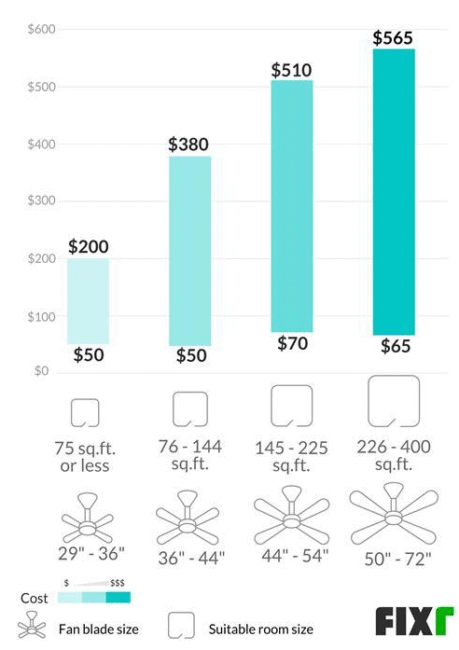Short answer: Yes, you can run most modern, UL-listed ceiling fans continuously without hurting the fan, but it’s not always smart to do so. Fans cool you, not the room, so running one when no one’s there wastes energy. In extreme heat, relying on a fan alone can even be risky; health agencies caution that fans may be ineffective when indoor temperatures reach the mid-90s °F (≈ 35°C) or higher unless you also use air conditioning or move to a cooler place.
Key takeaway: Run your fan as long as someone benefits from the breeze (especially with AC), but set a schedule or use a timer when rooms are empty—and be careful during heat waves.

Use low speed at night in bedrooms; schedule or timer helps you avoid accidental 24/7 use.
Why fans feel cool (and when 24/7 makes sense)
Ceiling fans don’t lower air temperature. They move air across your skin, boosting evaporation and convective heat transfer so you feel cooler. That “wind-chill” effect is why your home may feel comfortable at a higher thermostat setting when a fan runs. The U.S. Department of Energy (DOE) notes that in summer you can typically raise your thermostat about 4°F with a fan and maintain comfort.
Comfort science backs this up: the ASHRAE thermal comfort standard allows elevated air speed to offset higher indoor temperatures when occupants control that airflow. Tools based on the standard (like UC Berkeley’s CBE Comfort Tool) show how added air speed expands the “comfort envelope.”
But: Fans are not mini air-conditioners. In very hot rooms (mid-90s °F and above), public-health guidance warns that fans alone won’t prevent heat illness; prefer air conditioning or a cooling center in those conditions.
7 quick facts to decide if running a ceiling fan 24/7 is “okay” for you
- Safety & durability: Residential ceiling fans are designed for long, continuous operation and are tested against federal safety standards; always follow your model’s manual and ensure proper mounting and maintenance. (Tip: keep blades clean and balanced to reduce wear.
- Health limits in extreme heat: If a room is in the mid-90s °F or higher, a fan can make you feel hotter; use AC or go to a cooler location.
- Fans + AC save money: Using a fan lets you raise the AC setpoint about 4°F without losing comfort—lowering AC runtime. (See Formula 2 below to check your personal break-even.
- Empty room? Turn it off. Since fans cool people (not spaces), leaving one on in an unoccupied room is wasted energy.
- Seasonal direction matters: Run counterclockwise in summer for a cooling breeze; reverse to clockwise on low in winter to gently recirculate warm air.
- Costs are small but not zero: A typical 35–70 W fan running 24/7 adds roughly $4–$9/month to your bill at current U.S. average electricity prices. (See the cost table below, based on EIA’s 2025 data.)
- Efficient models help: ENERGY STAR® fans can be up to 44% more efficient than conventional fans, trimming the cost of long runtimes.

Counterclockwise in summer (breeze down), clockwise on low in winter (gentle updraft).
Your cost, in plain numbers (with two simple formulas)
Formula 1 — Monthly operating cost: Monthly cost ($) = (Fan watts ÷ 1000) × hours per day × 30 × electricity rate. Example with a 52 W fan, 24/7, and a U.S. 2025 average residential rate of $0.168/kWh: (52 ÷ 1000) × 24 × 30 × 0.168 = 37.44 kWh × 0.168 = $6.29/month. (EIA projects 2025 U.S. residential prices averaging about 16.8¢/kWh; check your state for local variation.) :contentReference[oaicite:12]{index=12}
“`
| Table 1 — Running a fan 24/7 for 30 days (U.S. average price $0.168/kWh) | ||
|---|---|---|
| Fan power (W) | Monthly energy (kWh) | Monthly cost (USD) |
| 35 | 25.2 | $4.23 |
| 50 | 36.0 | $6.05 |
| 70 | 50.4 | $8.47 |
| 100 | 72.0 | $12.10 |
Why these numbers matter: they’re small compared with AC costs, which is why pairing fans with AC is powerful—fans are inexpensive to run, and they let you raise the thermostat a little.
Formula 2 — “Fan + AC” break-even thermostat raise: Break-even ΔT (°F) = (Fan watts ÷ 1000 × rate) ÷ (AC kW × % savings per °F × rate). In words: the thermostat increase needed so that the money saved from your AC running less equals (or exceeds) the money the fan uses.
Example you can copy: Suppose your central AC draws 2.5 kW while running; a reasonable rule-of-thumb from DOE’s thermostat guidance is about ≈1% savings per °F for an 8-hour daily adjustment (actual savings vary). Your 50 W fan costs 0.05 kW × $0.168 ≈ $0.0084/hour. Break-even is about 0.0084 ÷ (2.5 × 0.01 × $0.168) ≈ 0.2°F. So raising the thermostat even a fraction of a degree while running the fan pays for the fan, and a few degrees (e.g., DOE’s 4°F tip) usually yields net savings. Use your own AC’s kW and local rate for accuracy. :contentReference[oaicite:14]{index=14}

Fans let you nudge the thermostat higher while staying comfortable—your AC runs less. “`
Three easy methods to decide your best runtime (and avoid needless 24/7)
- Comfort-first test (5 minutes): Sit where you spend time (sofa/desk/bed). Turn the fan on low. Bump the thermostat up 1–2°F. If you feel fine after 15 minutes, you’ve found a savings sweet spot; now set a timer for when you typically leave the room.
- Schedule + sensor (10 minutes): Use a wall control with a sleep timer or a smart plug with schedules (search “smart plug timer” in your app store or retailer of choice). Program off-times for when the room is usually empty (work hours, school drop-offs). Add an auto-off after 2–4 hours at night.
- AC synergy (15 minutes): In summer, set the fan to counterclockwise and increase your thermostat by 2–4°F. Track comfort for a few hours. If okay, keep the new setpoint. In winter, reverse the fan (clockwise) on its lowest speed for gentle mixing only when you’re in the room. :contentReference[oaicite:15]{index=15}
“`
| Table 2 — Which method is easiest and fastest? | |||
|---|---|---|---|
| Method | Steps (count) | Setup time (min) | Best for |
| Comfort-first test | 3 | 5 | Quick check before bed or TV time |
| Schedule + sensor | 4 | 10 | Busy households that forget to switch off |
| AC synergy | 4 | 15 | Homes with central or mini-split AC |

Set direction, add a simple timer, and pair with a thermostat tweak—easy wins. “`
Everyday scenarios (with realistic numbers you can copy)
To make the math concrete, here are three common situations and what 24/7 (or not) looks like. Prices use the EIA 2025 U.S. average of $0.168/kWh; swap in your local rate or utility’s time-of-use price if you have one.
“`
| Table 3 — What it costs in different everyday scenarios | |||
|---|---|---|---|
| Scenario | Runtime (h/day) | Energy (kWh/month) | Cost ($/month) |
| Bedroom nights (35 W, low) | 8 | 8.4 | $1.41 |
| Living room afternoons (50 W, medium) | 12 | 18.0 | $3.02 |
| Garage workouts (70 W, high) | 4 | 8.4 | $1.41 |
How to use this: If a room is occupied for just part of the day, schedule the fan for those windows. You’ll keep the comfort but avoid the round-the-clock run that adds dollars for no benefit.
“`
When running 24/7 is not okay (and how to fix it fast)
- Heat-wave risk: If indoor air is in the mid-90s °F+, fans alone won’t protect you. Use AC or a designated cooling space; check local resources if you don’t have AC.
- Empty rooms: Fans don’t cool rooms. Install a wall timer or use a smart plug scene (“Fan OFF when I leave”).
- Wrong direction: Summer needs counterclockwise; winter needs clockwise on low. A two-minute check fixes weak performance instantly.
- Dusty blades / wobble: Dust reduces airflow and can unbalance blades; clean monthly. If wobble persists, tighten screws, balance with a clip kit, or check mounting bracket.
Upgrade math: is an ENERGY STAR® fan worth it?
ENERGY STAR says certified ceiling fans are up to 44% more efficient than conventional models. If your current fan draws 70 W at your usual setting, a comparable certified model might use ~39 W for the same comfort. At 12 h/day, that saves about 11.1 kWh/month or $1.86/month at $0.168/kWh. Over a 5-month cooling season, that’s roughly $9–$10 per fan—more if your rate is higher or you run fans longer.
Key takeaway: If you run fans many hours every day, an efficient model plus a timer gives you comfort and control.
3 common “whoops” stories (and the simple fixes)
- “I left it on all weekend.” You went away Friday and came back Sunday to a spinning fan. Fix: add a 4-hour auto-off timer or a smart plug “Away” routine.
- “It’s summer but still muggy.” Fan on, but thermostat unchanged and windows open on a 95°F day. Fix: close windows during peak heat, use AC, and run the fan to allow a higher setpoint.
- “My winter bills are high.” Fan runs on medium, blowing a draft. Fix: reverse direction to clockwise and switch to the lowest speed—only when the room is occupied.
FAQs you actually care about
Does running a fan 24/7 wear it out? Quality ceiling fans are built for continuous operation. The bigger risks are imbalance (loose screws, dusty blades) and heat stress in an extremely hot, closed room—both preventable with routine care and sensible use.
How much does a fan cost per hour? At 50 W and $0.168/kWh, it’s about $0.0084/hour—less than a penny. (Use Formula 1 with your own numbers.
What about health guidance? During heat events, CDC and EPA recommend AC over fans if indoor temperatures are in the mid-90s °F or higher.
Final answers—clear and simple
Is it okay to run ceiling fans 24 hours a day? Yes, it’s generally safe—but it’s rarely the most efficient choice. You’ll get the best results when you:
- Run fans while someone’s in the room and pair them with AC to raise the thermostat a few degrees.
- Use timers/schedules so they don’t spin in empty rooms.
- Reverse direction and slow down in winter; clean and balance blades regularly.
- Switch to AC or a cooler location during heat waves when indoor temps reach the mid-90s °F+.
Next step: Pick one room tonight—set the fan, nudge the thermostat up by 2°F, and set a two-hour auto-off. If it still feels good, you’ve found your comfort-saving combo. Keep what works, schedule the rest, and enjoy the breeze.

A small device with a small cost—used smartly, a ceiling fan punches above its weight.
